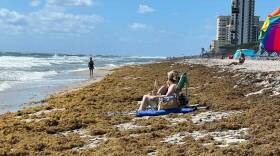-
Work on Sunset Beach is near completion. Eight other beaches are "fully open and ready for residents and visitors to enjoy this holiday season," according to the county.
-
If you've been on the coasts of Florida in the last couple of weeks, you've probably seen bunches of brown seaweed washing up on the shore.
-
A lot of opposition remains for emergency plans to renourish parts of Pinellas County's storm-flattened beaches. County commissioners are running into roadblocks from some beachfront property owners.
-
Gov. Ron DeSantis' signature undid a 2018 law requiring local governments to go through a judicial process before they can designate "dry sand" beach areas as publicly accessible.
-
Even seemingly tranquil water can pose unseen risks due to dangerous currents or water too shallow for diving. Sometimes, hours after leaving the water.
-
Under the new ordinance, first-time offenders will be fined $100. There's a $200 fine for a second offense and a $300 fine for additional violations.
-
Each individual patch of sargassum may only cover a small area. This means a particular beach could see a significant amount of algae, while an adjacent beach would not.
-
Scientists at the University of South Florida Optical Oceanography Lab are predicting what could be the state's worst seaweed season.
-
Northwest Florida lawmakers have said the 2018 law created fierce battles in Walton County between waterfront property owners and other people seeking to use beaches.
-
Lawmakers have moved forward with a repeal after widespread complaints about waterfront property owners in Walton County preventing people from using beaches.
-
Audubon of Florida and state wildlife officials remind beach-goers to stay away from nests, and keep dogs on leashes near or along the shoreline.
-
Some beaches in South Florida closed Saturday when the tar balls washed ashore. Those beaches have since reopened.
Play Live Radio
Next Up:
0:00
0:00
Available On Air Stations












